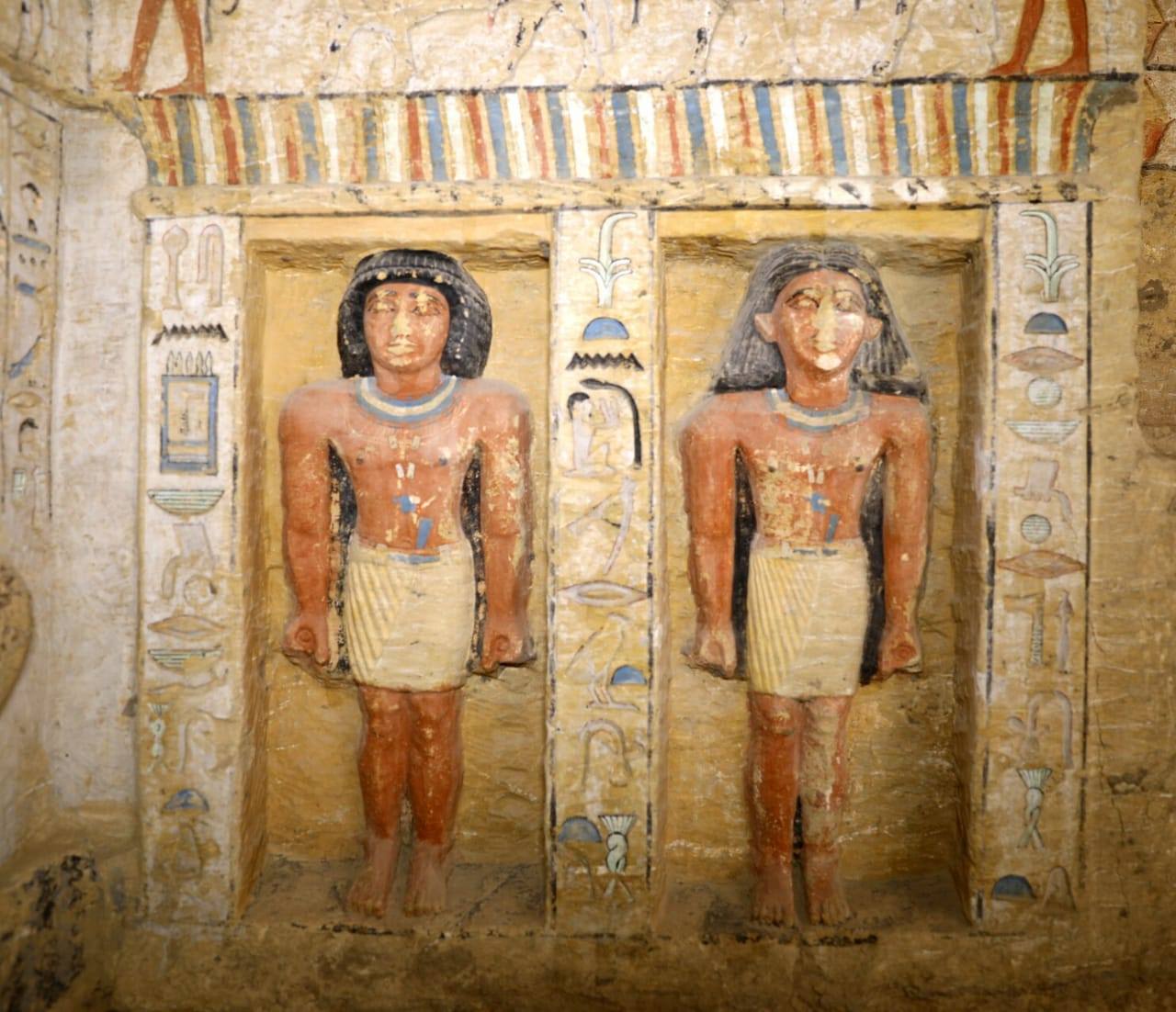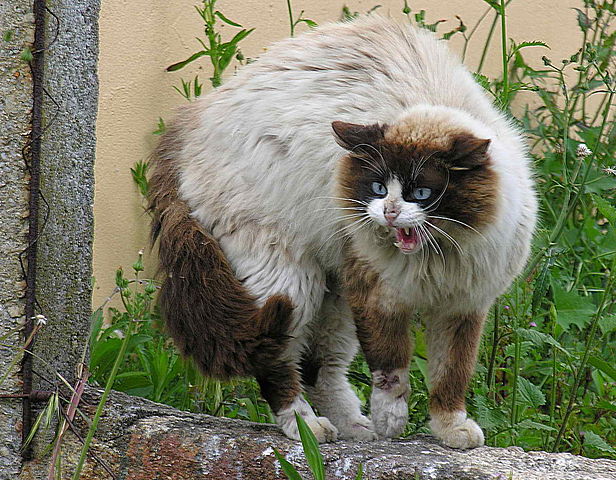| Clytaemnestra and Iphigeneia Louis Billotey |
Agamemnon seen glancingly through Hesiod's readers
Fifth-Dynasty Tomb Discovered in Saqqara
 CAIRO, EGYPT—Mostafa Waziri, secretary-general of Egypt's Supreme Council of Antiquities, announced the discovery of a 4,400-year-old tomb in Saqqara, according to a Live Science report. The intact tomb measures 33 feet long and about 10 feet wide. The well-preserved decorations depict the owner of the tomb, a royal purification priest named Wahtye, in scenes with his mother, wife, and other relatives making pottery and wine, and practicing religious observances. They are also represented by large, colorful statues placed in niches. Other scenes on the walls show musical performances, boats, the manufacture of the tomb’s funerary furniture, and hunting. Waziri said the tomb’s five burial shafts will be excavated. To read about the recent discovery of a type of ancient funeral parlor at Saqqara, go to “Mummy Workshop.”
CAIRO, EGYPT—Mostafa Waziri, secretary-general of Egypt's Supreme Council of Antiquities, announced the discovery of a 4,400-year-old tomb in Saqqara, according to a Live Science report. The intact tomb measures 33 feet long and about 10 feet wide. The well-preserved decorations depict the owner of the tomb, a royal purification priest named Wahtye, in scenes with his mother, wife, and other relatives making pottery and wine, and practicing religious observances. They are also represented by large, colorful statues placed in niches. Other scenes on the walls show musical performances, boats, the manufacture of the tomb’s funerary furniture, and hunting. Waziri said the tomb’s five burial shafts will be excavated. To read about the recent discovery of a type of ancient funeral parlor at Saqqara, go to “Mummy Workshop.”
Prehistoric Stone Circle Studied in Scotland
ABERDEENSHIRE, SCOTLAND—The Press and Journal reports that a complete stone circle located on farmland in northeastern Scotland has been studied by archaeologists for the first time. Made up of ten stones in total, the circle features a horizontal stone, known as the recumbent, which is flanked by two upright stones. Estimated to be between 3,500 and 4,500 years old, the circle is about ten feet smaller in diameter than other circles in the region. The stones are proportionally smaller as well, according to Adam Welfare of Historic Environment Scotland. To read in-depth about excavations of remains in Scotland dating to the same period, go to “Neolithic Europe's Remote Heart.”
Earthquake Damage Detected in Machu Picchu
 CUSCO, PERU—According to a report in The Peruvian Times, an earthquake estimated to have occurred around A.D. 1450 left lasting signs of damage on Machu Picchu’s Temple of the Sun and other buildings under construction during the reign of the Ninth Inca Pachacutec. “We see openings between rocks and stones, which is not typical of the Incas because they employed an impeccable, perfect construction,” said Carlos Benavente of the Cusco-Pata Research Project. “Some edges of the rocks are broken, which means that in the undulation of the earth, they hit each other, which caused the breaks.” Benavente then said that the architects changed tactics after the earthquake, and began building in trapezoidal shapes with giant stone blocks at the base of walls that narrowed at the top. He thinks the Incas stayed in the earthquake zone despite the dangers because the fissures in the earth also carried water. “They preferred to improve the structural conditions of their homes rather than move away from the water resource,” he explained. To read in-depth about Inca hydraulic engineering, go to “The Water Temple of Inca-Caranqui.”
CUSCO, PERU—According to a report in The Peruvian Times, an earthquake estimated to have occurred around A.D. 1450 left lasting signs of damage on Machu Picchu’s Temple of the Sun and other buildings under construction during the reign of the Ninth Inca Pachacutec. “We see openings between rocks and stones, which is not typical of the Incas because they employed an impeccable, perfect construction,” said Carlos Benavente of the Cusco-Pata Research Project. “Some edges of the rocks are broken, which means that in the undulation of the earth, they hit each other, which caused the breaks.” Benavente then said that the architects changed tactics after the earthquake, and began building in trapezoidal shapes with giant stone blocks at the base of walls that narrowed at the top. He thinks the Incas stayed in the earthquake zone despite the dangers because the fissures in the earth also carried water. “They preferred to improve the structural conditions of their homes rather than move away from the water resource,” he explained. To read in-depth about Inca hydraulic engineering, go to “The Water Temple of Inca-Caranqui.”
Denmark’s Domesticated Cats Grew Larger Over Time
 COPENHAGEN, DENMARK—Science Magazine reports that unlike most domesticated animals, cats have grown larger while adapting to life with humans. As a student at the University of Copenhagen, Julie Bitz-Thorsen and her adviser, archaeozoologist Anne Birgitte Gotfredsen, carefully examined and measured cat bones in museum collections found at Iron Age, Viking, and medieval sites in Denmark. The Viking-era cat bones, recovered from pits where their bodies had been dumped, bear marks suggesting the animals were skinned for their pelts, in addition to being raised for their pest-control abilities. Overall, the data suggests that on average, domesticated cats are about 16 percent larger today that they were in the Viking era. The researchers think expanding towns during the medieval period may have produced more waste, which attracted more pests, and provided cats with more food. Future studies could analyze cat DNA and look for chemical signatures of dietary changes. To read about mummification of animals in ancient Egypt, go to “Messengers to the Gods.”
COPENHAGEN, DENMARK—Science Magazine reports that unlike most domesticated animals, cats have grown larger while adapting to life with humans. As a student at the University of Copenhagen, Julie Bitz-Thorsen and her adviser, archaeozoologist Anne Birgitte Gotfredsen, carefully examined and measured cat bones in museum collections found at Iron Age, Viking, and medieval sites in Denmark. The Viking-era cat bones, recovered from pits where their bodies had been dumped, bear marks suggesting the animals were skinned for their pelts, in addition to being raised for their pest-control abilities. Overall, the data suggests that on average, domesticated cats are about 16 percent larger today that they were in the Viking era. The researchers think expanding towns during the medieval period may have produced more waste, which attracted more pests, and provided cats with more food. Future studies could analyze cat DNA and look for chemical signatures of dietary changes. To read about mummification of animals in ancient Egypt, go to “Messengers to the Gods.”
Think Like a Caveman, You Might End up Like one
An infamous Italian veterinarian and hunter, who found fame last year due to photos of him posing with a lion he had killed recently, slipped on ice and fell 100 feet to his death while hunting.[...] Ponzetto caused a lot of anger across the internet back in November of 2015, after a series of photos he posted online that showed him posing with trophy kills [...] Until he died, Ponzetto constantly defended his hobby, saying that veterinary work was not incompatible with hunting, neither in a moral sense or in a professional sense [...] He stated that he had done nothing wrong and that he was being criticized by people who do not know him. He claimed that he always loved his work and he has always loved animals no matter what. ['Infamous Lion Hunter Slipped And Fell 100 Feet To His Death During Hunt', Disclose TV, Dec 13 2018]
'Only interested in nature' (read article)
 |
| 'Only interested in the history' (think sbout it) |
Balangiga Bells back in Philippines after 117 years
via ABS-CBN News and other sources: The Balangiga Bells were taken by American forces over a hundred years ago.
The post Balangiga Bells back in Philippines after 117 years appeared first on SEAArch - Southeast Asian Archaeology.
One for the Christmas Stocking for Collectors
 |
| Greenlight publishing |
 |
| Stamp typology is the key |
Here is just a selection of the many useful books out there for those collectors wanting to identify the old stamps they find:
Egyptian archaeologists unearth tomb of ancient high priest
[[ This is a content summary only. Visit my website for full links, other content, and more! ]]
Le attualità della formazione ProfilCultura
Satellite data exposes looting
[[ This is a content summary only. Visit my website for full links, other content, and more! ]]
Report della presentazione dei risultati di WeAct3 – La Tecnologia per Arte, Cultura, Turismo, Territorio

Giovedì 13 dicembre 2018 si è svolta a Palazzo Barberini la presentazione dei risultati di WeAct3 – La Tecnologia per Arte, Cultura, Turismo, Territorio. Il progetto nasce dalla stretta collaborazione tra le Gallerie Nazionali di Arte Antica e l’Associazione Civita, con l’adesione di 11 partner privati italiani con oltre 20 specializzazioni differenti.
New study on cognitive archaeology and tactile responses to the lithic industry
[[ This is a content summary only. Visit my website for full links, other content, and more! ]]
Call for Papers (CCC 2019)
28.02.2019: [PANEL 1] What’s (new) in a name.
Hun Sen defends heritage site evictions
via Khmer Times, 05 December 2018: Cambodian Prime Minister speaking about recent evictions and demolishing of buildings in the Angkor Archaeological Park.
The post Hun Sen defends heritage site evictions appeared first on SEAArch - Southeast Asian Archaeology.
2018.12.36: Jerusalem zwischen Aachen und Bagdad: Zur Existenzkrise des byzantinischen Christentums im Abbasidenreich. Jenaer mediävistische Vorträge, 6
2018.12.37: Oscar Wilde and Classical Antiquity
2018.12.38: The Horse in Ancient Greek Art
Happy Birthday to Joyce Reynolds
An 'Alien' Detectorist, A Vanished Detectorist and A Lost Minerva Statue Found Masquerading as Flora
 |
| Minerva boxed as Flora |
Ms Fry saw the comedy show 'Detectorists' and cannot get it out of her mind, the whole article is framed around it:
there is an entire metal-detecting community out there. ‘The programme is very, very true to form,’ says Len. So there are websites, Facebook groups, YouTube channels (Len’s personal favourite is iDetect, by a chap called Harry which has over 28,000 subscribers) and two dedicated magazines, The Searcher and Treasure Hunting.
For more than 20 years now, Len Jackman, 66, has been searching for buried treasure. Every day, come rain, sun, sleet or storms, he buckles on his knee pads, pops on his collecting pouch and wellies and picks up his coffee flask, lunch box, spade and his trusty Minelab Equinox metal detector, complete with customised carbon fibre shaft for better handling. He then waves his wife Denise farewell and heads out into the fields surrounding his home near Witney, Oxfordshire. And there he’ll be for the next few hours, walking up and down the furrowed fields, his £600 gadget swooping backwards and forwards, headphones on and ears cocked and straining for the magical bleep, bleep, bleep of ancient buried gold. Which, mostly, has proved rather elusive.But, as attendees at the Treasure report launch know, Mr Jackman instead 'came across a 2,000-year-old Roman figure sitting in a large Flora margarine tub'.
It all started last December when Len was hunting a new stretch of fields near his home. He was chatting to the landowner who then showed him a small broken statuette, found on the land 15 years earlier by a fellow detectorist, dismissed as a copy, dumped in the Flora tub, and left in a room off the kitchen [...] when, six months later, he’d unearthed a few bits and bobs himself, he asked the farmer if he could take her along with his own hoard, to be identified and dated at the Museum Resource Centre in nearby Standlake [...] The minute the expert saw it, she was on the phone, one thing led to another and, last week, Len and Denise were up at dawn to attend the big unveiling ceremony at the British Museum.It is interesting to note that nothing is being said about the several bits of this item having been found in c. 2003 (NB right in the middle of the 'foot and mouth' outbreak when people were discouraged from going into the countryside) by someone that had been hoiking some fields and getting out substantial metal items like this one and not reporting them (there was no Oxford FLO until 2003). Fifteen years later, Mr Jackman is going over the same area and taking out what was left behind - how many other detectorists have 'done' this area over in the meantime? Where are all these finds? A search of the PAS database for Roman finds made in 2003 shows there are none from even remotely near Whitney. This is exactly what the Heritage Action Artefact Erosion Counter is telling s about. One item survived, because the landowner took it and curated it, what the metal detectorist walked off with in 2003 went into his collection, and thence... a skip headed towards the landfill, a car boot sale maybe, perhaps bought up as a bulk lot and then used to 'seed' a field prior to a commercial artefact hunting rally maybe? But it seems that very little of it entered the PAS database. It's all hidden from the public, whose heritage this is.
like many detectorists, Len is rightly obsessive about secrecy. His number is ex-directory. He makes me promise not to divulge the name of his village, or include photos of his car, in case he’s followed. The location of the Minerva is top secret and must remain so. He even has a detectoring alias: ‘Alien.’ ‘Last week, a drone was following me!’ he says. ‘You have to be careful.’Careful indeed that sweet lady journalists who you've sworn to secrecty does not write a caption like the one in the Mail: 'The Romano-British statuette of Minerva which was found in a margarine tub in Hailey, Oxfordshire'. Yep. But actually, Mr Jackman, the public have a right to that information. The past is not yours alone to have and hide.











